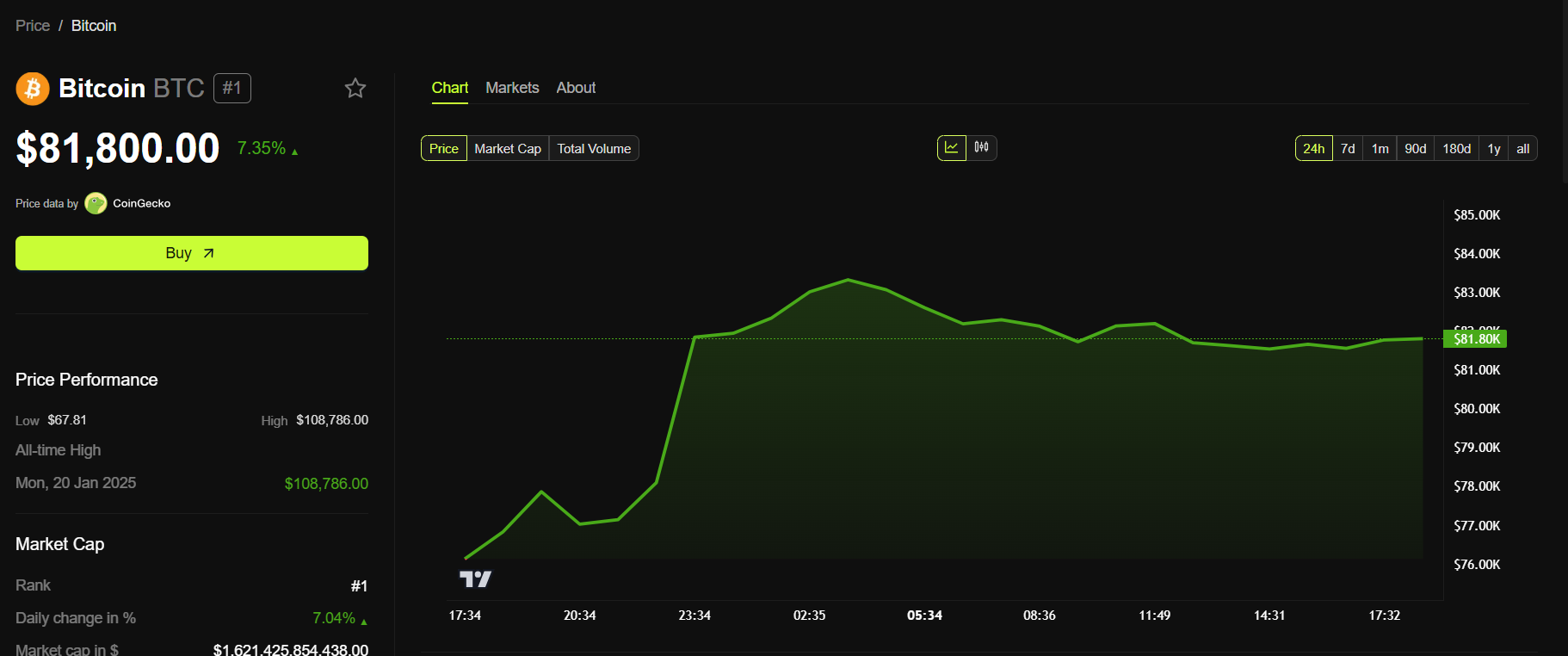| COINOTAG recommends • Exchange signup |
| 💹 Trade with pro tools |
| Fast execution, robust charts, clean risk controls. |
| 👉 Open account → |
| COINOTAG recommends • Exchange signup |
| 🚀 Smooth orders, clear control |
| Advanced order types and market depth in one view. |
| 👉 Create account → |
| COINOTAG recommends • Exchange signup |
| 📈 Clarity in volatile markets |
| Plan entries & exits, manage positions with discipline. |
| 👉 Sign up → |
| COINOTAG recommends • Exchange signup |
| ⚡ Speed, depth, reliability |
| Execute confidently when timing matters. |
| 👉 Open account → |
| COINOTAG recommends • Exchange signup |
| 🧭 A focused workflow for traders |
| Alerts, watchlists, and a repeatable process. |
| 👉 Get started → |
| COINOTAG recommends • Exchange signup |
| ✅ Data‑driven decisions |
| Focus on process—not noise. |
| 👉 Sign up → |
-
Bitcoin’s price stability comes on the heels of recent inflation data, reflecting investor sentiment amidst evolving economic indicators.
-
The latest CPI report indicates a significant easing in inflation, which may alter the trajectory for both Bitcoin and broader financial markets.
-
“The recent price fluctuations in Bitcoin could be interpreted as a response to complex global economic landscapes,” stated a COINOTAG analyst.
The Bitcoin market remains stable as inflation eases, with prices influenced by macroeconomic shifts and geopolitical events. Key indicators suggest a cautious optimism among investors.
Impact of Macroeconomic Factors on Bitcoin Pricing
The Consumer Price Index (CPI) serves as a pivotal indicator for economic conditions and inflationary trends. As evidenced by the recent data, which shows inflation easing to 2.4% in March compared to 2.8% in February, the crypto market responds accordingly. Following this announcement, Bitcoin’s price stabilized around $81,800, representing an increase of over 7% within just 24 hours.

Sourced from the Bureau of Labor Statistics, the monthly CPI data releases have become essential for market dynamics, particularly within the cryptocurrency sector. Bitcoin’s sensitivity to such macroeconomic metrics stems from their potential influence on the Federal Reserve’s policy decisions.
| COINOTAG recommends • Professional traders group |
| 💎 Join a professional trading community |
| Work with senior traders, research‑backed setups, and risk‑first frameworks. |
| 👉 Join the group → |
| COINOTAG recommends • Professional traders group |
| 📊 Transparent performance, real process |
| Spot strategies with documented months of triple‑digit runs during strong trends; futures plans use defined R:R and sizing. |
| 👉 Get access → |
| COINOTAG recommends • Professional traders group |
| 🧭 Research → Plan → Execute |
| Daily levels, watchlists, and post‑trade reviews to build consistency. |
| 👉 Join now → |
| COINOTAG recommends • Professional traders group |
| 🛡️ Risk comes first |
| Sizing methods, invalidation rules, and R‑multiples baked into every plan. |
| 👉 Start today → |
| COINOTAG recommends • Professional traders group |
| 🧠 Learn the “why” behind each trade |
| Live breakdowns, playbooks, and framework‑first education. |
| 👉 Join the group → |
| COINOTAG recommends • Professional traders group |
| 🚀 Insider • APEX • INNER CIRCLE |
| Choose the depth you need—tools, coaching, and member rooms. |
| 👉 Explore tiers → |
As inflation rises, the anticipation of interest rate hikes typically looms over risk-based assets, including cryptocurrencies. However, the recent dip in expected inflation can present a bullish case for Bitcoin, as it potentially reflects a more dovish stance from the Fed.
Recent commentary stemming from the March FOMC minutes and President Trump’s announcement regarding tariff pauses has shifted market expectations significantly, hinting at decreased likelihood of imminent rate hikes. The probability of a rate cut for May dropped from 57% to just 15%, marking a notable shift in sentiment.
| COINOTAG recommends • Exchange signup |
| 📈 Clear interface, precise orders |
| Sharp entries & exits with actionable alerts. |
| 👉 Create free account → |
| COINOTAG recommends • Exchange signup |
| 🧠 Smarter tools. Better decisions. |
| Depth analytics and risk features in one view. |
| 👉 Sign up → |
| COINOTAG recommends • Exchange signup |
| 🎯 Take control of entries & exits |
| Set alerts, define stops, execute consistently. |
| 👉 Open account → |
| COINOTAG recommends • Exchange signup |
| 🛠️ From idea to execution |
| Turn setups into plans with practical order types. |
| 👉 Join now → |
| COINOTAG recommends • Exchange signup |
| 📋 Trade your plan |
| Watchlists and routing that support focus. |
| 👉 Get started → |
| COINOTAG recommends • Exchange signup |
| 📊 Precision without the noise |
| Data‑first workflows for active traders. |
| 👉 Sign up → |
CPI’s Psychological Role in Bitcoin Investment
Bitcoin’s unique positioning as a potential hedge against inflation gives it a psychological edge in volatile markets. When inflation figures are pronounced, investors often consider Bitcoin as a viable alternative to traditional fiat currencies, particularly as a safeguard against diminishing purchasing power. This inclination could drive up interest in Bitcoin, promoting price resilience despite broader market fluctuations.
Moreover, traders constantly analyze CPI trends, which influence investment strategies. Adjustments based on CPI metrics allow institutional investors to navigate the complexities of risk management effectively. In a market where confidence is paramount, Bitcoin’s ability to attract capital during periods of economic uncertainty underlines its growing acceptance as a legitimate investment class.
| COINOTAG recommends • Traders club |
| ⚡ Futures with discipline |
| Defined R:R, pre‑set invalidation, execution checklists. |
| 👉 Join the club → |
| COINOTAG recommends • Traders club |
| 🎯 Spot strategies that compound |
| Momentum & accumulation frameworks managed with clear risk. |
| 👉 Get access → |
| COINOTAG recommends • Traders club |
| 🏛️ APEX tier for serious traders |
| Deep dives, analyst Q&A, and accountability sprints. |
| 👉 Explore APEX → |
| COINOTAG recommends • Traders club |
| 📈 Real‑time market structure |
| Key levels, liquidity zones, and actionable context. |
| 👉 Join now → |
| COINOTAG recommends • Traders club |
| 🔔 Smart alerts, not noise |
| Context‑rich notifications tied to plans and risk—never hype. |
| 👉 Get access → |
| COINOTAG recommends • Traders club |
| 🤝 Peer review & coaching |
| Hands‑on feedback that sharpens execution and risk control. |
| 👉 Join the club → |
Geopolitical Influences on Cryptocurrency Trends
The intertwining nature of geopolitical events and cryptocurrency movement is increasingly evident, as seen with President Trump’s recent stance on tariffs. The 90-day tariff pause alleviates some of the immediate pressures faced by Bitcoin investors. Market participants often react positively to news of regulatory changes, and Trump’s decision has resonated positively within the crypto space, inducing a swift price reaction.
This interaction with global economic events further solidifies Bitcoin’s reputation as a versatile investment vehicle, adaptable to changing geopolitical climates. As these dynamics evolve, traders remain vigilant, preparing for various outcomes driven by both domestic and international developments.
Conclusion
In summary, the interplay between macroeconomic indicators and geopolitical events significantly influences Bitcoin’s market performance. The latest CPI data indicating reduced inflation rates has bolstered investor confidence, showcasing a calculated investor strategy responding to external economic signals. As traders position themselves for future market movements, Bitcoin remains a focal point in investment portfolios, reflecting its potential role as both a safeguard and a speculative asset. The outlook for Bitcoin suggests that its journey within the increasingly complex financial landscape is only just beginning.
| COINOTAG recommends • Members‑only research |
| 📌 Curated setups, clearly explained |
| Entry, invalidation, targets, and R:R defined before execution. |
| 👉 Get access → |
| COINOTAG recommends • Members‑only research |
| 🧠 Data‑led decision making |
| Technical + flow + context synthesized into actionable plans. |
| 👉 Join now → |
| COINOTAG recommends • Members‑only research |
| 🧱 Consistency over hype |
| Repeatable rules, realistic expectations, and a calmer mindset. |
| 👉 Get access → |
| COINOTAG recommends • Members‑only research |
| 🕒 Patience is an edge |
| Wait for confirmation and manage risk with checklists. |
| 👉 Join now → |
| COINOTAG recommends • Members‑only research |
| 💼 Professional mentorship |
| Guidance from seasoned traders and structured feedback loops. |
| 👉 Get access → |
| COINOTAG recommends • Members‑only research |
| 🧮 Track • Review • Improve |
| Documented PnL tracking and post‑mortems to accelerate learning. |
| 👉 Join now → |







